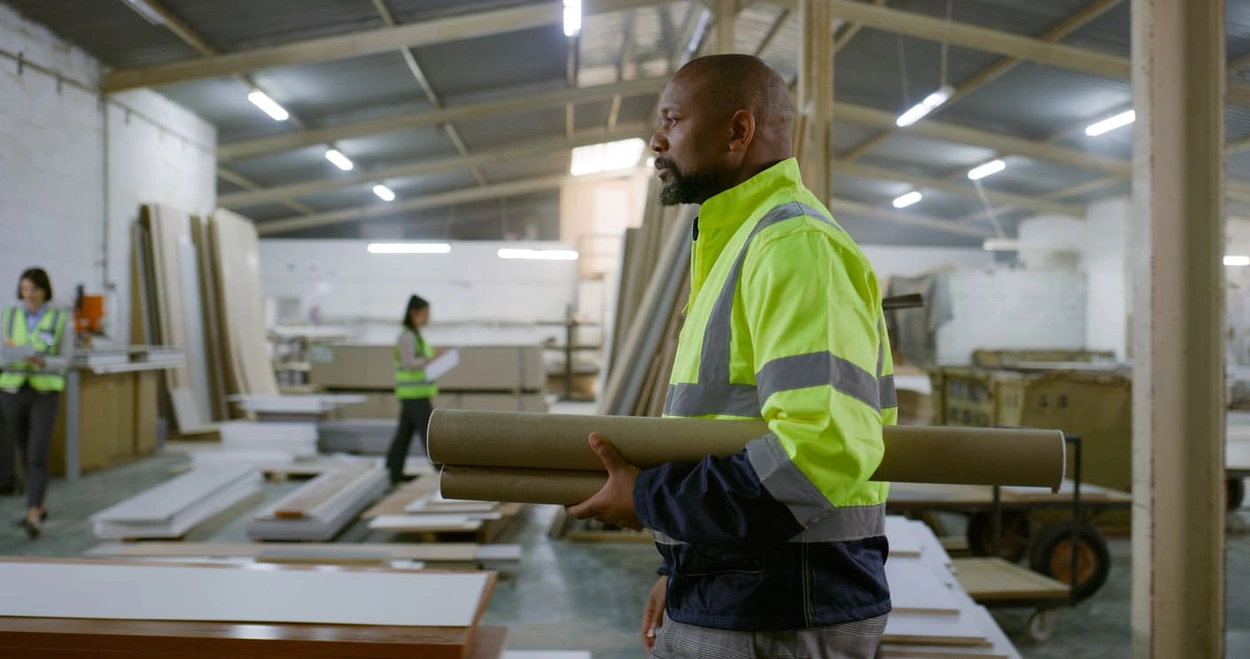Blog
Filter categoryCategory
Digital Upskilling for Construction Industry Automation

Pencetakan Teknis
|28 abr 2022
Digital Upskilling for Construction Industry Automation
Construction industry automation is still elusive for many businesses and historically, the architecture, engineering and construction (AEC) sector has struggled when it comes to the digitization of workflows. The key challenges often arise from the need to retrain or upskill a workforce that has been responsible for the manual, low-value processes that digital automation workflows are designed to replace.
Instead of phasing out or eliminating the roles of these workers, Deloitte Consulting1 recommends integrating AI, robotic process automation (RPA) and digital process automation (DPA) to automate existing workflows. Then, create a “superlearning” environment or “learning in the flow of work and life” to upskill or train these workers for higher-value, higher-productivity responsibilities.
Deloitte has outlined the following strategies for upskilling workers to create a future-proof digital workforce for construction industry automation2:
• Adopt creative approaches to reward employee upskilling and promote a culture of continuous learning throughout the employee’s lifecycle
• Take a strategic approach to workforce planning to determine how digital process automation might impact employee roles and require retraining and development
• Pursue transformation projects, keeping in mind the impact on the workforce and budget agreements for upskilling or redeploying affected employees
• Refocus the corporate learning culture to adopt “superlearning”, a data-driven approach centered on individual, team, and organizational capabilities, plus integrating “learning in the flow of work and life” across all work functions and lines of business
The emergence of the hybrid office due to the Covid-19 pandemic has been a catalyst for construction industry automation and digital collaboration technology to streamline workflows among disparate locations – main office, home office, and construction sites in the field. In its October 2021 update3 on U.S. employment trends3, Gallup reported that 45% of full-time U.S. employees worked remotely from home as part of a hybrid office environment, with 25% full-time and 20% working partial hours. Additional data implies that the hybrid office is here to stay, with 61% of Gallup respondents expecting to work on a hybrid schedule for another year or longer, while 27% anticipate working remotely full-time. Clearly, a new approach to workforce planning and employee training and development is needed, along with flexible digital technology for the office.
Future-proof digital collaboration
Construction industry automation starts with digital collaboration across the AEC enterprise. Communication and collaboration among office personnel, remote at-home workers, and engineers in the field are key areas where upskilling employees in construction industry automation processes are most needed. Automated workflows and mobile workflows to support a hybrid digital workforce with intuitive and simple-to-use hardware and software can help AEC firms solve the digital skills shortage.
For example, AEC firms rely on large format printers to create precise design documents and blueprints for clients. Today’s cloud-based printer technology is advanced, but simple to learn and use, so employees in the digital workforce have a faster digital learning curve. Whether in the office, home office or construction site, AECs can deliver their best work by printing, scanning, and sharing documents for instant digital collaboration using familiar smartphones and digital tablets. Plus, employees can increase their productivity using automated printer features to streamline and accelerate production workflows. With the right large-scale printer-plotter in-house, AECs can provide employees with more time and opportunities to focus on the upskilling training and development they need to take higher-level, core business responsibilities.
On the construction site, as well, AEC firms are challenged to fill the skills gap as construction industry automation strategies include the use of AI-enabled robotics. According to LinkedIn’s “2020 Emerging Jobs Report”4, job opportunities in robotics and engineering companies for persons with AI knowledge have gone up by 74% over the past four years. However, a survey of 1,900 global construction businesses commissioned by robotics solutions provider ABB Robotics revealed that 91% of the respondents are anticipating a “skills crisis” over the next 10 years5. Additionally, 44% indicated that they currently have difficulty recruiting for construction jobs because applicants lack the required skills. With digital upskilling, construction companies that adopt or anticipate adopting robotics technology can launch training and development programs in AI, Machine Learning, and other digital skills for their existing employees. As robotic process automation fuels growth and innovation for construction and engineering firms, a work culture of digital upskilling will also drive personal career growth and satisfaction in a digital workforce.
How digital upskilling benefits the business and employees
Investing in digital upskilling for construction industry automation ensures that workers will be ready with new skills to enable business continuity during the digital transformation of the workplace. Additionally, offering on-site upskill training empowers workers to become more proficient in their existing roles as well as take on new responsibilities to further their careers. Instead of facing a digital skills crisis, AEC companies will have a competitive advantage with an in-house digital workforce already familiar with the latest in digital process automation, cloud computing, AI and robotic process automation, and more.
As remnants of the COVID-19 pandemic continues to alter the way people live and work, digital upskilling for digital automation is a proactive way to continue the sustainability of the workforce not only in the company itself, but as a society as a whole6. However, according to a global skills report by research firm Coursera7, the U.S. still ranks 29th globally in workforce digital skills. Clearly, bridging the digital skills gap is a necessity rather than an option for creating business value and competitive advantage in the future. A 2020 study by UK research firm PwC revealed that companies with employee upskilling programs saw threefold improvement in innovation8. With forecasts of 97 million new digital jobs emerging globally by 20259, AEC firms investing in digital upskilling for construction industry automation now will be ahead of the curve with a highly skilled digital workforce ready for the future of work.
Learn More
Learn more about how HP DesignJet large format printers can help support construction industry automation strategies for AEC companies as well as improve productivity and digital collaboration in the field and for employees in a hybrid office environment.
References
1“Superlearning Reskilling, upskilling and outskilling for a future-proof workforce”, June 29, 2020. https://www2.deloitte.com/us/en/insights/focus/technology-and-the-future-of-work/reskilling-the-workforce.html //
2“Deloitte Guide to Responsible Automation” https://www2.deloitte.com/content/dam/Deloitte/uk/Documents/digital-hub/deloitteuk-bitc-guide-to-responsible-automation.pdf
3“Remote Work Persisting and Trending Permanent” by Lydia Saad and Ben Wigert, Ph.D., Gallup, October 12, 2021. https://news.gallup.com/poll/355907/remote-work-persisting-trending-permanent.aspx
42020 Emerging Jobs Report, LinkedIn, https://business.linkedin.com/content/dam/me/business/en-us/talent-solutions/emerging-jobs-report/Emerging_Jobs_Report_U.S._FINAL.pdf
5ABB Robotics Advances Construction Industry Automation to Enable Safer and Sustainable Building, ABB Robotics, May 2021
https://new.abb.com/news/detail/78359/abb-robotics-advances-construction-industry-automation-to-enable-safer-and-sustainable-building
6Why Digital Upskilling is a Crucial Part of Sustainability, World Economic Forum, December 2021
https://www.weforum.org/agenda/2021/12/digital-upskilling-sustainability/
7Coursera Global Skills Report 2021 Finds US Behind in Digital Skills, Ranked 29th Globally, June 2021, https://www.businesswire.com/news/home/20210609005235/en/Coursera-Global-Skills-Report-2021-Finds-US-Behind-in-Digital-Skills-Ranked-29th-Globally
8Why Upskilling Needs to Be a Part of Your ESG Strategy, July 2021
https://www.pwc.co.uk/private-business-private-clients/blog/why-upskilling-needs-to-be-a-part-of-your-esg-strategy.html
9The Future of Jobs Report 2020, World Economic Forum, https://www3.weforum.org/docs/WEF_Future_of_Jobs_2020.pdf
<iframe src="undefined"></iframe>You Might Also Like

Everything you need to know about choosing a plotter printer

Best Compact Large Format Printers for Small Business Offices

How to Choose the Best Industrial Plotter for Your AEC Business

Best Budget Plotter Printers for Small Business Print Shops

Which to Pick: Plotter or Laser Printers for Technical Drawings

Main Trends in the Technical Printing Sector in 2024

Top 7 Professional Large Format Printers to Buy in 2024

Get Photo-Quality Prints With a Large-Scale Colour Plotter Printer

The Key Benefits of Large Format Printing for Spatial Data in GIS

Considerations to Help You Get the Right Digital Blueprint Printing Machine for Your AEC Business

10 Creative Uses for Large Format Poster Printers

5 Ways a Large Format Printer Can Streamline Your Business Workflow

Plotters and Their Types: Uncovering Plotter Cost Considerations

Everything You Need to Know About Plotters and Their Applications

Optimising Printer and Plotter Capabilities for Small Businesses

Uses of Plotters for Small Businesses: Affordable Solutions for Big Impact

How to Print a Poster With HP's DesignJet T850 Printer

5 Factors to Consider When Buying an Inkjet Plotter

The Best Plotter Printers for Creating GIS Map Systems

Latest Innovations in Printing Technology: Top 5 Uses of Large Format Printers in the Construction Sector



